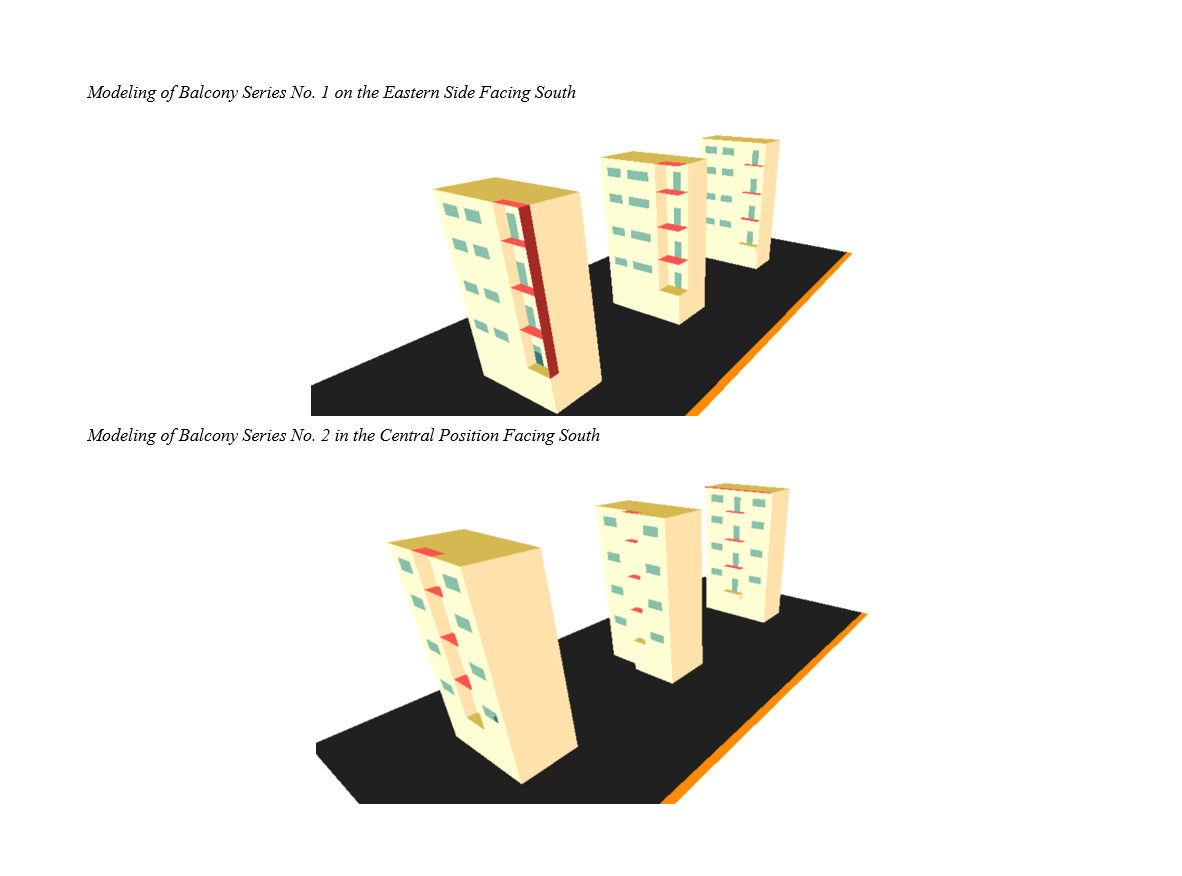Smart Shading Devices: Innovation in the Design of Semi-Open Spaces to Enhance Thermal Comfort in Hot and Arid Cities – Case Study: Mashhad
Keywords:
smart shading devices, innovation, semi-open space, thermal comfort, MashhadAbstract
This study investigates the impact of smart shading device design on the thermal behavior of semi-open spaces in four-story buildings in the city of Mashhad. Using two simulation software programs (Honeybee and Envi-met), the results indicate that models with greater shading coverage (three enclosed sides) demonstrate superior thermal performance on the summer solstice compared to models with minimal shading (one enclosed side). Additionally, balconies located at the central façade of the building exhibit the best thermal behavior on the summer solstice, while centrally placed balconies with two enclosed sides yield the best results on the winter solstice. The study concludes that balcony design should ensure three shaded sides during summer and two shaded sides during winter. It is recommended that balconies be designed with two enclosed sides and a movable canopy in order to achieve both optimal summer thermal performance and desirable winter conditions. In response to the research questions, the study analyzes the factors affecting the thermal behavior of semi-open spaces and the variables influencing the design of shading devices across different seasons. Overall, this research contributes to the optimal design of smart shading devices in Mashhad and may serve as a practical guide for architects and designers aiming to enhance thermal comfort in semi-open spaces.
References
Abdallah, A. S. H., Hussein, S. W., & Nayel, M. (2020). The impact of outdoor shading strategies on student thermal comfort in open spaces between education buildings. Sustainable Cities and Society, 102124. https://doi.org/10.1016/j.scs.2020.102124
Aghapour, A., & Taban, M. (2020). Investigating the effect of vegetation cover on improving thermal comfort conditions in open spaces Ahvaz.
Aghniaey, S., & Lawrence, T. M. (2018). The impact of increased cooling setpoint temperature during demand response events on occupant thermal comfort in commercial buildings: A review. Energy and Buildings, 173, 19-27. https://doi.org/10.1016/j.enbuild.2018.04.068
Akbari, H., & Hosseininajad, F. S. (2019). Building orientation angles for solar radiation utilization; Case study: Tehran city. Geographical Research, 34(3), 427-436. https://doi.org/10.29252/geores.34.3.427
Aleksandrowicz, O., Saroglou, T., & Pearlmutter, D. (2023). Evaluation of summer mean radiant temperature simulation in ENVI-met in a hot Mediterranean climate. Building and Environment, 245, 110881. https://doi.org/10.1016/j.buildenv.2023.110881
Badino, E., Ferrara, M., Shterpi, L., Fabrizio, E., Astolfi, A., & Serra, V. (2021). Modelling mean radiant temperature in outdoor environments: contrasting the approaches of different simulation tools
Baniani, F., Me'marzia, K., Habibi, A., & Fattahi, K. (2018). Spatial continuity in the transition from open to enclosed spaces. Architectural Thought, 4(2), 63-76. https://www.google.com/url?sa=t&source=web&rct=j&opi=89978449&url=https://civilica.com/doc/1040827/&ved=2ahUKEwjAgIC2zLKOAxV6RqQEHYVJDa8QFnoECBgQAQ&usg=AOvVaw1MchOSmnefRmGcrBpNZnUA
Baruti, M. M., Johansson, E., & Åstrand, J. (2019). Review of studies on outdoor thermal comfort in warm humid climates: challenges of informal urban fabric. International Journal of Biometeorol, 63, 1449-1462. https://doi.org/10.1007/s00484-019-01757-3
Fattahi, M., & Sharbatdar, M. (2023). Machine-learning-based personal thermal comfort modeling for heat recovery using environmental parameters. Sustainable Energy Technologies and Assessments, 57, 103294. https://doi.org/10.1016/j.seta.2023.103294
Jafarian, R., & Mahmoudian, A. (2024). Traditional Iranian Architecture, Thermal Comfort, and Energy Consumption Balance (Case Study: Architectural Fabric of the Historical City of Sirvan). Ilams Studies(32), 94-119. https://www.ilamstudy.ir/article_213526.html
Jun, H., & Fei, H. (2024). Research on multi-objective optimization of building energy efficiency based on energy consumption and thermal comfort. Building Services Engineering Research & Technology, 45(4), 391-411. https://doi.org/10.1177/01436244241240066
Khoshbakht, Y., Madi, H., & Azmoudeh, M. (2020). Investigating the geometry of urban blocks on outdoor thermal comfort during the cold season (Case study: Hamadan city) Tehran. https://www.google.com/url?sa=t&source=web&rct=j&opi=89978449&url=https://civilica.com/doc/1028612/&ved=2ahUKEwim5qiezrKOAxWSUKQEHep2FnIQFnoECCUQAQ&usg=AOvVaw37Bm-K-DyR05WJAss1C2Nd
Moghadam Ziabari, A., & Mozaffari, F. (2018). The effect of balconies on natural ventilation, thermal comfort, and reduction of external noise in residential buildings. Architectural Studies, 6, 1-8. https://www.google.com/url?sa=t&source=web&rct=j&opi=89978449&url=https://ensani.ir/fa/article/390809/
Pakzad, J., Torabi, M., Ghasemi, M., & Torkzad, N. (2018). Theoretical Foundations and Process of Urban Design. Shahidi Publications.
Parsaee, M., Demers, C. M. H., Potvin, A., Lalonde, J. F., Inanici, M., & Hébert, M. (2021). Biophilic photobiological adaptive envelopes for sub-Arctic buildings: Exploring impacts of window sizes and shading panels' color, reflectance, and configuration. Solar Energy, 220, 802-827. https://doi.org/10.1016/j.solener.2021.03.065
Pourdeihimi, S. (2018). Climatic Language in Sustainable Environmental Design: Application of Climatology in Architectural Planning and Design: Micro Scale. Shahid Beheshti University Press and Publications Center.
Qin, Z., Lu, B., Jing, W., Yin, Y., Zhang, L., & Wang, X. (2024). Creating comfortable outdoor environments: Understanding the intricate relationship between sound, humidity, and thermal comfort. Urban Climate, 55, 101967DO - 101910.101016/j.uclim.102024.101967.
Ribeiro, C., Ramos, N. M. M., & Flores-Colen, I. (2020). A Review of Balcony impacts on the Indoor Environmental Quality of Dwellings. Sustainability, 12(16), 6453. https://doi.org/10.3390/su12166453
Rocha, A., Pinto, D., Ramos, N. M., Almeida, R. M., Barreira, E., Simões, M. L., & Sanhudo, L. (2020). A case study to improve the winter thermal comfort of an existing bus station. Journal of Building Engineering, 29, 101123. https://doi.org/10.1016/j.jobe.2019.101123
Rodríguez-Algeciras, J., Tablada, A., & Matzarakis, A. (2018). Effect of asymmetrical street canyons on pedestrian thermal comfort in warm-humid climate of Cuba. Theoretical and Applied Climatology, 133(3-4), 663-679. https://doi.org/10.1007/s00704-017-2204-8
Roshan, G. R., Almomenin, H. S., da Silveira Hirashima, S. Q., & Attia, S. (2019). Estimate of outdoor thermal comfort zones for different climatic regions of Iran. Urban Climate, 27, 8-23. https://doi.org/10.1016/j.uclim.2018.10.005
Roshan, G. R., Farrokhzad, M., & Attia, S. (2017). Defining thermal comfort boundaries for heating and cooling demand estimation in Iran's urban settlements. Building and Environment, 121, 168-189. https://doi.org/10.1016/j.buildenv.2017.05.023
Sanagar Darbani, E., Rafieian, M., Hanaei, T., & Monsefi Praperi, D. (2018). Evaluation of climate change impacts on outdoor thermal comfort changes using the Physiological Equivalent Temperature (PET) index in Mashhad city. Geographical Research Quarterly, 33(3), 38-57. https://doi.org/10.29252/geores.33.3.38
Sudarsanam, N., & Kannamma, D. (2023). Investigation of summertime thermal comfort at the residences of elderly people in the warm and humid climate of India. Energy and Buildings, 291, 113151. https://doi.org/10.1016/j.enbuild.2023.113151
Wu, Y., Zhang, Z., Liu, H., Li, B., Chen, B., & Kosonen, R. (2023). Age differences in thermal comfort and physiological responses in thermal environments with temperature ramp. Building and Environment, 228, 109887. https://doi.org/10.1016/j.buildenv.2022.109887
Zhang, Z., Zhang, Y., & Jin, L. (2018). Thermal comfort in interior and semi-open spaces of rural folk houses in hot-humid areas. Building and Environment, 128, 336-347. https://doi.org/10.1016/j.buildenv.2017.10.028
Zhao, Q., Sailor, D. J., & Wentz, E. A. (2018). Impact of tree locations and arrangements on outdoor microclimates and human thermal comfort in an urban residential environment. Urban Forestry & Urban Greening, 32, 81-91. https://doi.org/10.1016/j.ufug.2018.03.022

Downloads
Published
Submitted
Revised
Accepted
Issue
Section
License
Copyright (c) 2024 Danial Goshayeshi (Author); Seyyed Majid Mofidi Shemirani; Shabnam Teimourtash , Mohsen Tabassi (Author)

This work is licensed under a Creative Commons Attribution-NonCommercial 4.0 International License.









